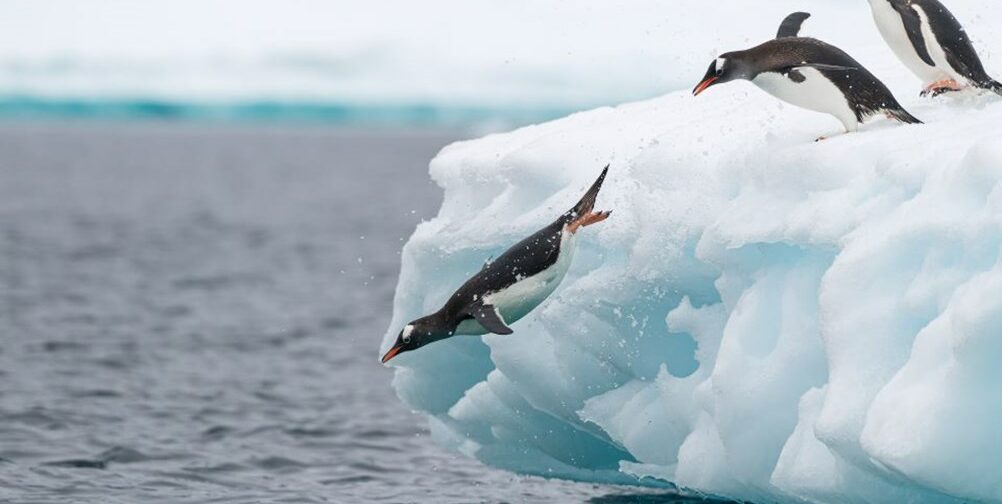To be sure, National Geographic decided to whack the penguins again as part of the imaginary meltfest. “An icy world,” it intones breathlessly, “is in meltdown, as penguin population shifts signal trouble/ Marine life off the Antarctic Peninsula needs protection as sea ice declines and fishing boats move in to take more krill.” How bad is it? “Gentoo numbers on the [Antarctic] peninsula have increased rapidly – more than tripling at many sites during the past 30 years – and the birds are expanding south into new areas that had been too icy for them, leveraging their flexible foraging and breeding strategies.” Oh the penguinity.
National Geographic does its best to counterfeit a melting Antarctic/dying penguin crisis anyway. “In stark contrast, their sister species – the smaller chinstrap penguins and the sleek, black-headed Adélie penguins – have declined by upwards of 75 percent at many of the colonies where gentoos are thriving.” That’s not good, is it? Especially as “Penguins are important sentinels for the wider health of the oceans.” What’s more “Penguin scientists aren’t worried that chinstraps and Adélies will disappear from the planet – some colonies beyond the peninsula appear to be stable, and some may even be increasing.” Wait a minute? They’re all thriving? Your headline had us worried for a minute there.
Not to be outdone, AP decided to melt the Arctic again because it’s worked so well every other time. And smoke the polar bears while they’re at it: “Majestic, increasingly hungry and at risk of disappearing, the polar bear is dependent on something melting away on our warming planet: sea ice.” And never mind Code Red; that went out with global heating. “Scientists and advocates point to polar bears, marked as ‘threatened’ on the endangered species list, as the white-hot warning signal for the rest of the planet — ‘the canary in the cryosphere.’ As world leaders meet in Glasgow, Scotland, to try to ramp up efforts to curb climate change, the specter of polar bears looms over them.” We might seem callous if we insisted that you can’t be a spectre until you actually die and, as Susan Crockford keeps pointing out, they’re not.
Still, they will. Because about that ice:
“Julienne Stroeve, a University of Manitoba researcher, says summers without sea ice are inevitable. Many other experts agree with her. Former NASA chief scientist Waleed Abdalati, now a top University of Colorado environmental researcher, is one of them. ‘That’s something human civilization has never known,’ Abdalati said. ‘That’s like taking a sledgehammer to the climate system and doing something huge about it.’ The warming already in the oceans and in the air is committed – like a freight train in motion. So, no matter what, the Earth will soon see a summer with less than 1 million square kilometers of sea ice scattered in tiny bits across the Arctic. The big question is when the Arctic will ‘look like a blue ocean,’ said Mark Serreze, director of the National Snow and Ice Data Center. Maybe as early as the 2030s, most likely in the 2040s and almost assuredly by the 2050s, experts say.”
Would those be the experts who said 2004, and 2013, and 2014, and 2015, and 2016, and 2017? And we don’t want to quibble about when human civilization can be said to have started, but an ice-free Arctic ocean was commonplace for thousands of years up to about 8,000 years ago.
Still, it must be true this time, right? Thus we now hear that “A penguin has been found, starving and exhausted, in New Zealand – 3,000 kilometres from its Antarctic home. The Adelie penguin, nicknamed Pingu by locals, was discovered at Birdlings Flat, a settlement south of Christchurch on South Island. Scientists have warned that global warming could make this epic voyage more common for the birds as they go in search of fish.” What? What scientist said global warming would cause penguins to swim to New Zealand? We want their names.
It turns out some penguin rescuer gave Pingu a “fish smoothie” and chucked him back in the water with cheery hopes that he “can make the 1,864-mile journey home”. If so he is unlikely to meet a horde of his fellows going the other way. “Only two other Adelie penguins have been discovered in New Zealand, one in 1993 and the other in 1962.” Which doesn’t exactly make for a trend, or vindication for whoever that scientist who said was.
Still, better panic because “experts have warned that if the journey becomes a trend for penguins it could be a sign of trouble…. Climate change threatens to harm Adelie penguins’ habitat and food supply and block migration routes. In areas where global warming is now a problem, Adelie populations have decreased by 65 per cent in the past 25 years…. Within the next 40 years, Adelie populations are expected to decline or even drop off in areas of Antarctica that are experiencing rising temperatures. Antarctica’s Emperor penguins also face climate change challenges. Experts say the species could face significant difficulties by 2100, as melting sea ice disrupts breeding and reduces numbers.”
This time for sure.



So, in the coldest year in Antarctica for 60 years, a penguin turns up where its warmer. Or put another way, in response to a so called warming world, the penguin goes where its warmer? Either way - maybe the penguin just got lost, or is just intrepid!
Ursus Maritimus...is a sea bear, not a polar bear. It has a niche, eating seals, walruses, and incautious visitors to Svalbard, and when that niche fades away, Ursus Maritimus will segue back to the European Brown Bear from whence it came...